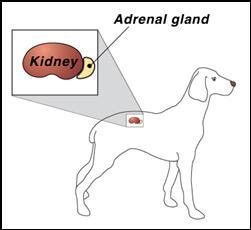Addison’s Disease (Hypoadrenocorticism)

Addison’s disease is a disease that results from the reduction of corticosteroid secretion from the adrenal gland.
The adrenal gland is a small gland located near the kidney that secretes several different substances that help regulate normal body functions. The adrenal gland is made up of two layers, the cortex (outer layer) and the medulla.
The cortex secretes the corticosteroid hormones, including glucocorticoids and mineralocorticoids.
The medulla is part of the sympathetic nervous system and secretes adrenaline (generally not affected by Addison’s disease).
Glucocorticoids are necessary for the function of many systems in the body, including responding to stress, controlling weight, fighting infections, keeping blood sugar levels in check, fat and protein metabolism, managing mineral balance, the structure of connective tissue, some white blood cell production and skin health. Glucocorticoids are partly responsible for the fight or flight response in dogs.
Mineralocorticoids have an influence on the electrolytes sodium and potassium in the body – they help regulate these electrolytes, particularly in stressful situations.
In Addison’s disease, either or both of glucocorticoid and mineralocorticoid can be deficient.
Addison’s disease is primarily a disease of young to middle-aged female dogs; however, a dog of any age and either sex can develop the disease.
The symptoms of Addison’s disease are very vague and many animals may have symptoms for a long time before the disease is diagnosed. Some of the more common symptoms are:
Lethargy
Anorexia (lack of appetite)
Weight loss
Vomiting
Muscle weakness
Dehydration
Low blood pressure
Depression
Heart toxicity
Blood in faeces and/or diarrhoea
Painful abdomen
Increased thirst
Tremors or shaking and shivering
Pain in the hind quarters
‘Addisonian crisis’, where the dog collapses in a state of shock due to an imbalance of electrolytes and metabolism during a period of stress. Potassium levels elevate and disrupt normal functions of the heart and blood pressure drops to dangerously low levels.
The symptoms may wax and wane over time (months or years).
Causes of Addison’s disease include:
Destruction of the glands by the body – this is a process where the body attacks and kills its own tissue in ‘immune mediated destruction’.
Infections in the gland from granulomatous diseases such as histoplasmosis or blastomycosis
Tumours, or amyloidosis of the gland.
Failure of the pituitary gland to secrete ACTH, which stimulates the adrenal gland to work (due to tumour, inflammation or injury) – this is referred to as secondary hypoadrenocorticism, and does not affect the electrolyte balance.
The hypothalamus stops producing CRH, which is the hormone that controls the adrenal gland (due to tumour, inflammation or injury).
Addison’s disease is diagnosed by a blood test called the ACTH stimulation test. However, it is likely that other tests (such as a chemistry profile and blood count) will be done first to rule out more common diseases. Dogs with Addison’s disease often have elevated BUN and elevated creatinine, as well as reduced blood glucose. The blood count test may also show chronic anaemia, a high number of eosinophils and an increased number of lymphocytes.
Serum biochemistry testing may reveal an abnormally higher level or potassium and an accumulation in the blood of urea nitrogenous waste products that are usually excreted out of the body through the urine). Sodium and chloride levels may be loser, calcium levels may be higher, and there may be increased liver enzymes (including ALT and AST) and low blood sugar.
With the ACTH challenge test, an injection of the adrenal stimulating hormone ACTH is given – a normal dog will respond by an increase in blood cortisol, whilst a dog with Addison’s disease will not have this increase.
The standard treatment involves using drugs (injections or oral medication) to replace the glucocorticoids and mineralocorticoids in the body. Dogs with low bodily fluids are also given intravenous fluids.
A dog with Addison’s disease will need medication and monitoring for the rest of his life, but they should be able to return to their favourite activities.
Using complementary and alternative forms of care can help the dog to feel better and may even reduce the dependence on some medications.
Diet and nutrition – it is very important that a dog with Addison’s disease has a strong nutritional foundation.
Herbs can be beneficial, but these need to be agreed with the vet as they can impact medications, blood tests and other procedures.
Probiotics can be helpful supplements, but again, discuss with your vet first.
Cloves and Dates are the suggested food remedies in Chinese medicine
Rock Rose (Bach Flower Remedy) can be administered to alleviate acute symptoms
Cushing’s disease is the opposite of Addison’s disease, where too much corticosteroid is secreted from the adrenal gland.
